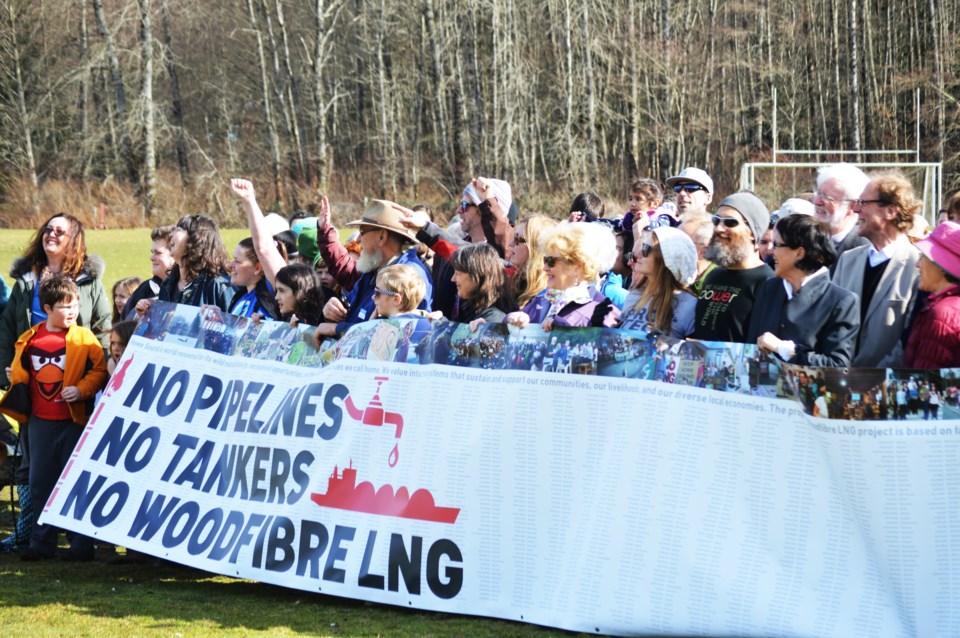Pamela Goldsmith-Jones hosted town hall LNG meetings in Squamish, Gibsons, and West Vancouver to overflowing crowds.
In Squamish, organizers had to open up the stage and bring in chairs. Still, more people stood in the halls near the door to hear the discussion, bringing the total to roughly 300 people.
The meeting was hosted by MP Pam Goldsmith-Jones as part of the federal government’s renewed environmental assessment process.
Because of the high turnout, Goldsmith-Jones limited speakers to three minutes, and most seemed to finish what they had to say within the allotted time.
She outlined the changes that the new federal government is making to the environmental assessment process, saying they are currently using an interim process until the new one is finalized.
“It will take several months to re-do the process,” she said.
Goldsmith-Jones highlighted the key components, including not sending any projects back to the “starting line,” making decisions based on science, a need for public input, especially First Nations, and including greenhouse gas emissions are within the scope of assessments.
When it came time for the public to speak, more than 30 people got up to the microphone and were almost unanimously opposed to Woodfibre LNG’s proposed plant.
The lone voice of assent was the first speaker. Long-time resident Astrid Andersen read a letter saying she was perturbed by the opposition, adding that people against the LNG proposal ignored projects more damaging to the environment. She also said that these people seemed to feel it was fine to run gas lines through their properties yet were opposed to LNG, calling this stance “hypocritical NIMBYism.”
Andersen also cited potential economic benefits, including tax revenue, from the project.
“To have impact, we have to have export. Tourism is not enough,” she said.
She received some applause for her presentation, yet no one else spoke in favour. The opponents covered a range of reasons, including fracking safety and emissions, the threats to recovering sea life in Howe Sound, a lack of economic benefits to provincial and local governments as well as communities, the shift of benefits to Indonesia and owner Sukano Tanato, his business practices, concern about compressor stations and the need to protect the natural assets of the Sea to Sky Corridor.
“We’ve had for the first time in living memory orcas,” said Eoin Finn, a member of My Sea to Sky, which opposes the project.
One theme that emerged was the number of people, including area political figures like Brenda Broughton and Ken Melamed, admit they had initially been on board with the idea of expanding B.C.’s natural gas industry, saying it seemed like a better alternative to other fossil fuels, but that in recent years and after viewing research, they had changed their views for several different reasons, such as fracking emissions or problems with the province’s environmental assessment process. Melamed said, “Let’s turn our eyes to how we can use the gas locally and responsibly.”
Some were longtime residents, while others were relatively new to B.C. Nick Sopczak said he had grown up in the shadow of refineries in Sherwood Park, Alta., at a time when people were living well off the oil boom, but he said he wanted a different life.
“I chose Squamish because I wanted clear air and I wanted to look at the mountains,” he said, adding, “We are our environment. There’s no separation.”
At times, there were questions about points of order and whether the meeting was slanted in favour of one view or another. Early on, someone in the audience asked how the speakers were being presented, as almost all were on one side of the issue, to which Goldsmith-Jones responded they were speaking in the order in which they had signed up.
Later, Tracy Saxby of My Sea to Sky asked for a show of hands from the crowd as to who is favour or opposed, but Goldsmith-Jones interrupted, saying the move was not appropriate as it could intimidate people from expressing their views, although another person later said that having a show of hands was part of the democratic process.
Prior to the meeting, opponents gathered in the school field to chant their position and hold up a banner showing the many signatures they had gathered from people against the plan.
“We’ve managed to get over 8,000 signatures on the Howe Sound petition,” Saxby said. Almost 2000 have come from Bowen Island.



